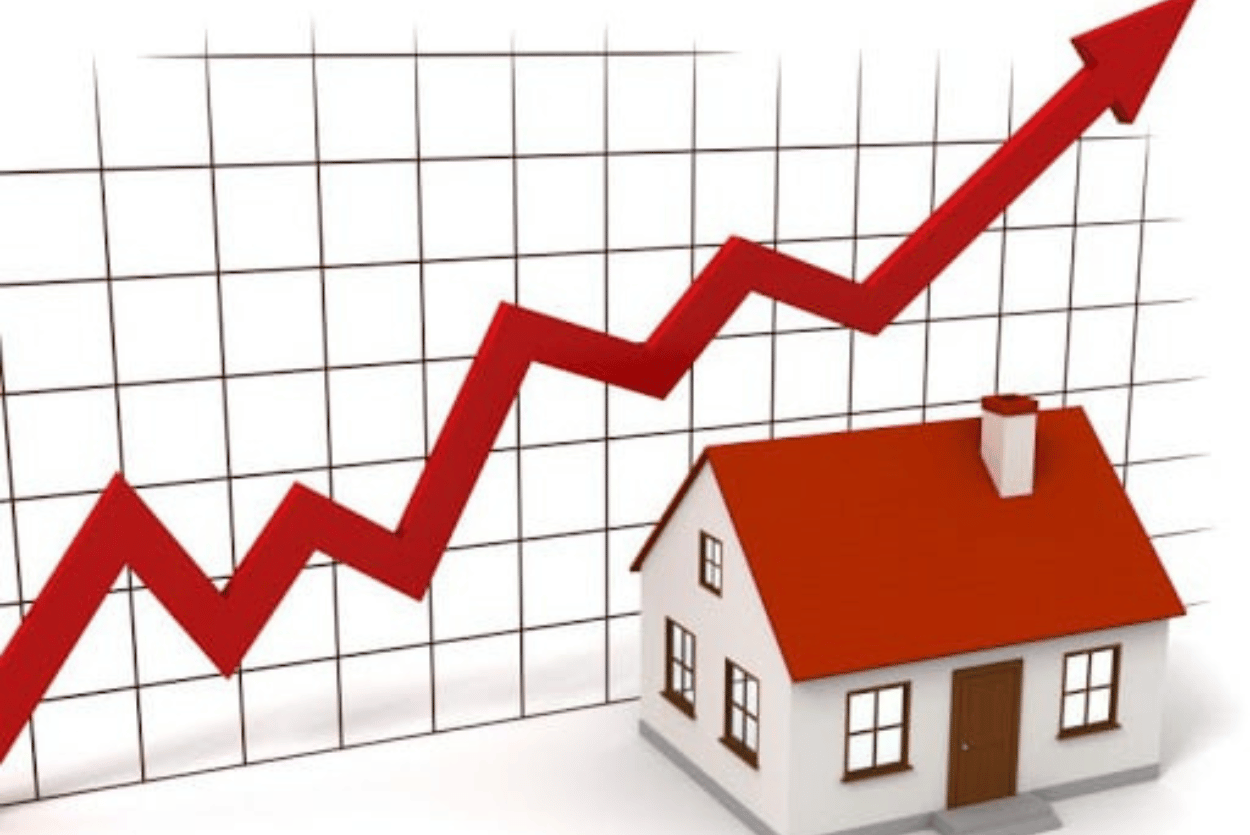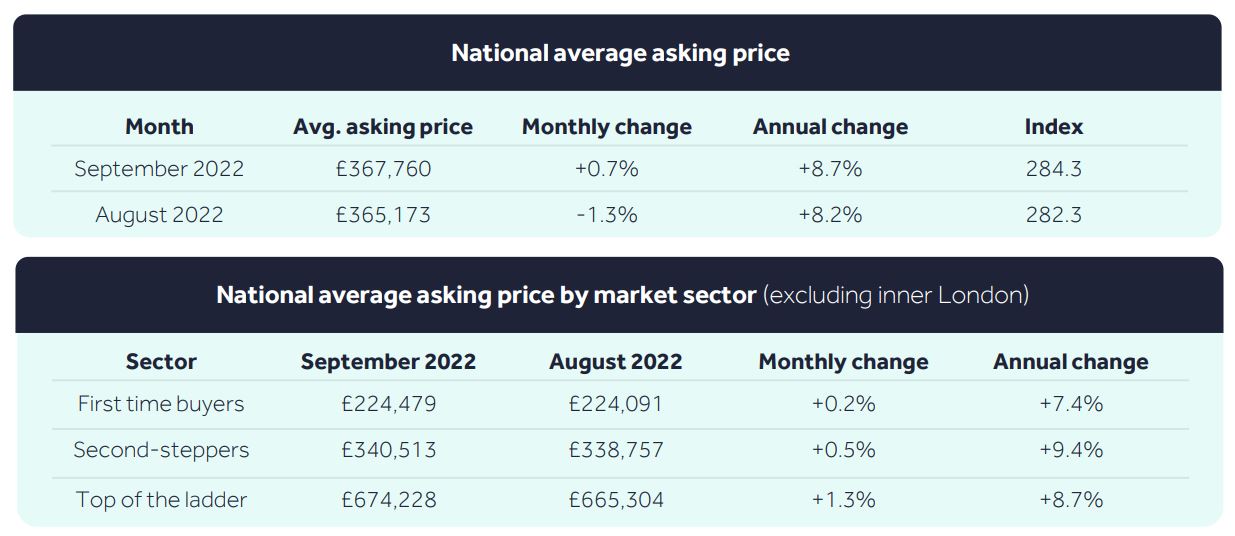
- The average price of property coming to the market rises by 0.7% (+£2,587) in the month to £367,760:
- This month’s rise in new seller asking prices is in line with the ten-year September average increase of 0.6%
- The middle and high-end market sectors are driving price rises this month, with a new record average asking price (£340,513) in the “second-stepper” category (three bedrooms and non-detached with four bedrooms)
- First-time buyers facing cost pressures, though new stamp duty cuts may provide some additional support:
- The stamp duty cut from Friday’s mini-budget means that two-thirds of homes (66%) are now exempt from stamp duty for first-time buyers in England, and a third of all homes are exempt for all buyers (33%)
- Average monthly mortgage payments for new first-time buyers are currently £1,057, which is 40% of an average gross salary for the first time since November 2012. They will jump to £1,114 per month if lenders pass on the latest interest rate rise of 0.5%
- The market remains surprisingly resilient despite growing economic pressures:
- Buyer demand is up 20% on the pre-pandemic five-year average, and the stamp duty cut could stimulate some more demand over the next few months
- The number of homes coming to market has risen back to 2019 levels, giving buyers more choice
The average price of property coming to market rises by 0.7% (+£2,587) this month to £367,760. This is in line with the average September rise of 0.6% over the last ten years. Price growth this month is driven predominantly by the middle and high-end market sectors, with the “second stepper” category (three bedrooms and non-detached with four bedrooms) reaching a new record average asking price of £340,513. Buyer demand in these sectors is up by 2% even compared to the frenetic market of last year, while more choice is now also available compared with 2021. These numbers suggest that for those who can, moving up the ladder to a home with more space remains a priority, even at a time when personal finances are stretched.
“The end of the summer break and the start of the new school term is usually a time when we see renewed focus from buyers, as those with plans to move see an autumn window of opportunity ahead of them. Price growth this month in the middle and high-end sectors highlights that even when finances are more stretched, many of the reasons for looking to move up the ladder remain. This might be a growing family, or needing more space for other reasons, and the numbers suggest that those who can afford to are still prioritising moving. Prices are likely to remain strong while demand continues to outweigh supply. However, it is as important as ever to price competitively, especially in the sectors where there is now more choice, as there is a fine line between a realistically priced home and a home that feels overpriced when many buyers are making every pound count.”
Tim Bannister Rightmove’s Director of Property Science
First-time buyers are facing cost pressures, though the announcement to cut stamp duty may provide some support. The average monthly mortgage payment for new first-time buyers putting down a 10% deposit has now reached £1,057, which is 40% of an average gross salary for the first time since November 2012. Following the Bank of England’s latest interest rate rise of 0.5%, with the base rate now at 2.25%, this number could jump to as high as £1,114 per month if lenders pass on the rise to new first-time buyers. A 10% deposit on a first-time buyer type home is now 57% higher than 10 years ago, while average salaries have increased by 32% over the same time, making it increasingly difficult to save the necessary deposit.
These factors combined have perhaps contributed to demand in the first-time buyer sector being down by 8% on the same period last year, though to put this into context, demand for first-time buyer type properties is still up by 27% compared with the five-year pre-pandemic average between 2015 and 2019. The announcement to cut stamp duty for first-time buyers may also drive some additional demand in the coming months, though because it is permanent, any increase in demand is likely to be steady rather than a surge. Two-thirds of homes (66%) are now exempt from stamp duty for first-time buyers in England, and by raising the stamp duty threshold from £125,000 to £250,000, a third of all homes currently for sale (33%) are now completely exempt from stamp duty in England, compared with 7% before the cut.
The overall market remains surprisingly resilient despite the headwinds. Demand continues to ease slightly from the heady levels of last year as expected, but even with the fall in first-time buyer demand, total demand is down by only 2% on the same period in 2021, and the stamp duty cuts could stimulate more demand. Compared with the pre-pandemic five-year average, total buyer demand is up by 20%. The number of homes coming to market has risen by 16% this month compared to this time last year, which is a return to 2019 levels.
“The housing market continues to be extremely resilient even in the face of the economic headwinds that are stretching household finances. The rising cost of living is increasingly playing a role in some buyers’ considerations, as they look at their budgets and what they can afford. Demand has been softening over the last few months, but Friday’s announcement is likely to stimulate some more demand. If it does lead to a big jump in prospective buyers competing for the constrained number of properties for sale, then it could lead to some unseasonal price rises over the next few months. The first-time buyer threshold change means we could see more first-time buyers who can afford it making a jump to a bigger home as their first move. With more buyer demand we would also expect that the current trend of more properties coming to market will continue, offering more choice for buyers.”
Tim Bannister Rightmove’s Director of Property Science
Agent’s View
“The property market has been driven by inadequate supply for decades, and whilst there has been reports of a slowdown in demand, particularly for new build homes, we have seen that the prime regional markets are continuing to thrive. This has been helped by hybrid working becoming more conventional, which has increased the numbers of buyers looking for larger homes outside of London. From what we’ve seen, house prices have remained resilient in spite of the cost-of-living crisis and interest rate rises, and a shortage of stock has continued to underpin price rises. Those with bigger budgets tend to be impacted less by the rise in interest rates or the increases in cost of living, and this has helped ensure that prime markets are continuing to flourish.”
Richard Freshwater, Director at Cheffins in Cambridge







